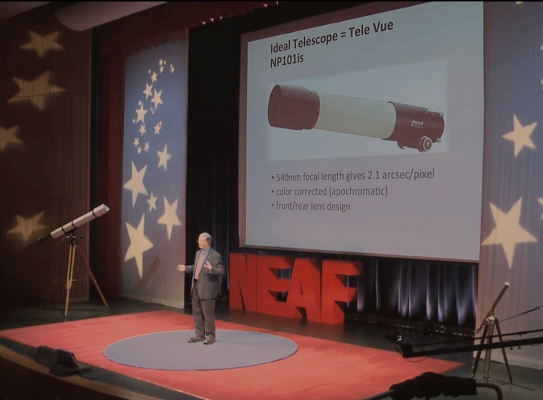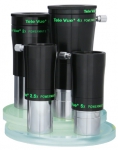TELE VUE SCIENTIFIC PART 2
Doing Science with Tele Vue Optics

In the last installment, our scientific path went from “polar to solar.” (If you missed it, please go back and read Tele Vue Scientific Part 1.) In Part 2 of this multi-part blog post on the use of Tele Vue gear in science, we reveal Sneakey research with Tele Vue Powermates and how a compact Tele Vue-NP101is telescope proved once again that lights are “all askew in the heavens.” All this research was done using our standard gear with products bought off-the-shelf — the same as you would receive from Tele Vue.

Introduction
Have you ever lost your keys? Let’s hope someone with a telescope, Tele Vue Powermate, and camera wasn’t around. A pair of researchers at the University of California San Diego created such a setup to learn if teleduplication of your house keys was possible. They described their goal in the abstract of their published paper: “Using modest imaging equipment and standard computer vision algorithms, we demonstrate the effectiveness of physical key teleduplication — extracting a key’s complete and precise bitting code at a distance via optical decoding and then cutting precise duplicates.” The bitting code describes the depth of cuts that make the key fit the associated lock. The difference in depth between unique cuts can be as little as 0.3 mm. The test subjects were a set of “the most popular residential key types in the U.S.” Tests were done in ideal conditions in the lab and in real-world scenarios in the field.
Their system of divining the bitting code from the images relied on a custom machine-vision system the researchers implemented called Sneakey. It would create several guesses for the bitting code based on an image of the key. The code determined by Sneakey was fed into a commercial key cutter to create a duplicate key. The duplicate was then tested on the lock belonging to the subject key.
Conclusion
Did it work? The published paper said: “All key shots taken at 100-feet were decoded within three guesses” and “7 out of 10 keys were precisely decoded within the first guess.” Only one of the 195-foot keys was decoded and the experimenters blamed wind guests for that. However, don’t worry that anyone is telescopically stealing your keys: just keep them out of sight and you’ll be safe!
The study, “Reconsidering physical key secrecy: teleduplication via optical decoding” was published in the Proceedings of the 15th ACM conference on Computer and communications security, in October 2008.

Introduction
Long-time blog readers will remember the excitement of the 2017 Great American Eclipse and our reporting on an experiment to confirm Albert Einstein’s General Relativity Theory with our Tele Vue-NP101is. The experiment undertook the tricky task of photographing stars near the Sun during the eclipse and comparing their positions to images taken months earlier when the Sun wasn’t nearby. Any change in the position of the stars would confirm that gravity deforms the fabric of space itself!
This experiment was first successfully conducted at the 1919 Solar Eclipse, with equipment-laden expeditions setting up camp in Brazil and the island of Principe off the coast of Africa. Technical problems prevent all but one of the multiple telescopes on these expeditions from getting a usable image. It was a plate from Principe where the stellar positions were measured. When the results were published proving “Einstein was Right,” it made worldwide headlines and a once-obscure German physicist became a sought-after celebrity.

Over the following decades, scientific expeditions shipped large amounts of gear to solar eclipse paths around the world to re-confirm the results. This included setups with photographic plates a half-yard (0.45-meters) on a side and 28-foot (8.5-meters) long refractors. The last published eclipse expedition took place in 1976. While the results of all these efforts generally agreed with the deflection coefficient predicted by General Relativity, the uncertainty of the measurement was at best 6%. In the 1970s astronomers gave up chasing eclipses to verify the bending of space and switched to monitoring radio sources (usually extragalactic sources like quasars) near the Sun’s path through the sky. The advantage here is the large number of radio sources that allow multiple experimental opportunities without having to wait years for an eclipse to happen. Observations could be made day or night without being impacted by clouds. The radio work agreed with predicted results to many decimal places and the visual light experiment went the way of the rotary phone.

The Modern Eclipse Experiment
Enter Dr. Don Bruns, a retired optical physicist and 50-year amateur astronomer. He got the idea to revive the eclipse experiment using readily available, modern, portable, amateur astronomy equipment. He bet that the improvements in optics and imaging could best the accuracy of the eclipse experiment conducted by professionals over the last century. But it was still no easy task, as he explained in his experimental paper.
The closest measurable stars have deflections typically 0.3 arcsec to 1 arcsec. In order to measure these with even 10% precision, the locations of the stars need to be determined to within 0.03 arcsec to 0.10 arcsec.
Accuracy like that is a tall order and pushes amateur equipment to limit. So Dr. Bruns choose his equipment carefully.
A review of commercially available telescopes and cameras led to selections of the Tele Vue Optics, Inc. NP101is refractor and the Finger Lakes Instrumentation, Inc. ML8051 CCD camera. A Software Bisque MyT Paramount provided celestial tracking.
Dr. Bruns wrote in detail on why he selected the Tele Vue-NP101is.
A refractor avoids a central obscuration that adds scattered light and reduces contrast. The stellar image needs to be about two pixels diameter; a larger image diameter reduces pixel contrast and so might not reveal enough stars while a smaller image diameter might make determining centroid locations impossible. The preferred refractor was a Petzval design so that an internal optical alignment scheme could be implemented.

After years of meticulous planning, the gear was set along the eclipse path in Casper, Wyoming. An automated script pointed the scope toward stars in the vicinity of the eclipse and to calibration areas on either side of the event. Exposure was automatically calculated and the necessary images were taken.
Conclusion
It turns out that Dr. Bruns’ results were spot on. As he wrote in his paper on the experiment: “The final result was a deflection coefficient L = 1.752 arcsec, compared to the theoretical value of L = 1.751 arcsec, with an uncertainty of only 3%.”
In his paper, he discussed improvements in conducting this experiment at future solar eclipses.
There are three longer and easily accessible total eclipses occurring over land in the next ten years, and this paper outlines the equipment and techniques that might be used. While technical changes in commercially available equipment during this period are anticipated, there is little reason to choose a different telescope. The Tele Vue Optics NP101is telescope mounted on the Software Bisque Paramount performed perfectly, are well matched, and are easily transportable. The best camera for future eclipse experiments is still to be determined, but the capabilities of Finger Lakes Instrumentation ML8051 was proven in this experiment.
His paper, Gravitational Starlight Deflection Measurements during the 21 August 2017 Total Solar Eclipse was published in Classical and Quantum Gravity, March 6, 2018. You can also read about Dr. Bruns’ lecture and visit to our booth at the 2018 Northeast Astronomy Forum (NEAF) here: Einstein was Right! Completing the 1919 Relativity Experiment at the 2017 Solar Eclipse.
- Learn what makes Tele Vue scopes special by reading our Tele Vue APO Design and Build “Secrets” blog post.


